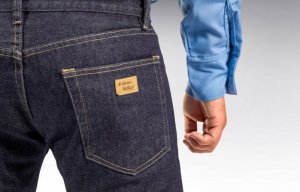
Cone Denim and Westex extend FR denim partnership
This summer, a leading UK retailer M&S has launched its new Plan A 2025 sustainability plan.

30th August 2017
Innovation in Textiles
|
London
This summer, a leading UK retailer M&S has launched its new Plan A 2025 sustainability plan. According to the plan, by 2020 100% of M&S products will have at least one Plan A sustainability attribute, and by 2025 every product will have attributes which address all priority social, ethical and environmental impacts.
“As the Designer and Buyer for men’s denim we wanted to see how we could play our part in building a more sustainable future, using new innovations to offer more sustainable choices in denim for our customers,” the company explains.

“We are already sourcing more responsible cotton, and by 2019 all our cotton will be sourced more sustainably. In addition to this, we wanted to see if we could engineer a jean that was hardwearing, had an even lower environmental impact in terms of its overall energy use, and used sustainable finishes, whilst keeping a focus on the style and quality that our customers want.”
The company identified that the below were important considerations:
“Cotton that is grown responsibly is a must. At M&S we support responsibly sourced cotton through the Better Cotton Initiative which exists to make global cotton production better for the people who produce it, better for the environment it grows in, and better for the sector’s future,” the company reports. “We also wanted to create selvedge denim, for its authentic and stylish look, hard wearing quality and the artisan way it’s woven with self-finished edges.”
The brand worked with Jeanologia, which specialises in sustainable and efficient technologies for the garment finishing industry, to reduce chemicals, water and energy used on a selection of jeans within our collections.
Jeanologia has also developed the Environmental Impact Measuring software, which is a tool to analyse the environmental impact in the washing process. It is divided into three categories: low, medium and high impact. The benchmark score of EIM for a pair of jeans is 33 or less for low impact.
“We worked hard to engineer the colour of the fabric to be dyed as close as possible to the desired finished look, and then used a washing process that used less time in the machine compared to a standard wash, which meant less water, less energy and fewer chemicals were used,” the company says. “When the EIM results came back with a score of 21 it was a pleasant surprise, as in all of our discussions with factories and laundries we had never heard of a score this low.”
The company then went on to contacting thread suppliers and zip tape manufacturers about using recycled polyester for both components. M&S worked with leather suppliers for the leather back-patch, which it managed to get to be bio degradable.
The end result is a range of four colours of slim fit, more sustainable selvedge denim jeans, with recycled polyester thread and zip tape and a biodegradable leather patch.

Business intelligence for the fibre, textiles and apparel industries: technologies, innovations, markets, investments, trade policy, sourcing, strategy...
Find out more